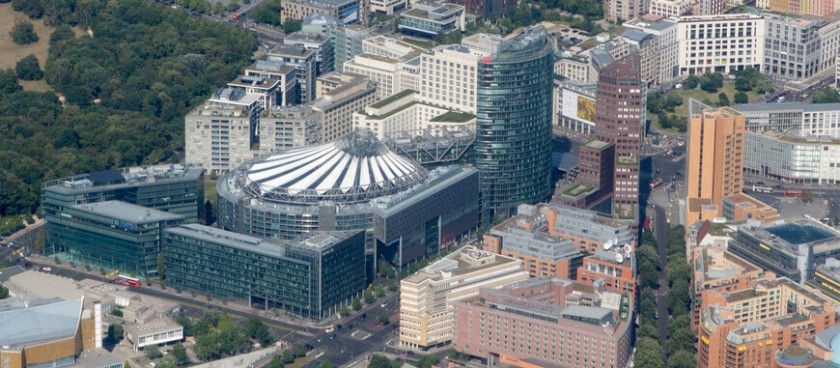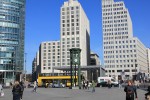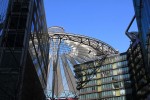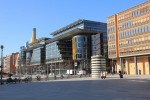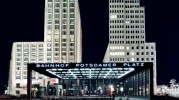- #DE34
- Potsdamer Platz, 10785 Berlin, Germany
- info@potsdamer-platz-arkaden.de
- https://potsdamerplatz.de/
- 52.5096618, 13.3759334 Copy to clipboard Copy
-
#Family time , #Viewpoints
Before World War II, Potsdamer Platz was one of the busiest crossroads in Europe and the centre of the social, political and cultural life of the German capital.
Historically, Potsdamer Platz formed at the city gate leading to Potsdam. Due to the location of the royal and imperial residences in Potsdam, this destination was one of the most sought after. It was on Potsdamer Platz that built the first long-distance train station. To regulate heavy traffic, it was here that the first European traffic light appeared in 1924. Today on Potsdamer Platz, a copy of this traffic light - the tower - has been restored. In addition to the train station, its location on the square of trendy restaurants, film studios, lounges, cinemas and hotels made it one of the main squares in Berlin at the beginning of the 20th century.
Everything changed after World War II. In addition to the destruction associated with the bombing of the allied forces, by a dramatic coincidence, it was on Potsdamer Platz that the "border of three countries" - the three sectors of Berlin's occupation - Soviet, British and American - lay. After the beginning of worsening relations between the Allied countries with the Soviet Union on June 21 August 1948, a strip appeared on the asphalt for the first time, marking the border between the Soviet and Western sectors.
The dramatic history of Potsdamer Platz, one might say, repeats the history of Berlin - from a meteoric rise to a crushing fall and a new rebirth from the ashes. Today Potsdamer Platz is one of the city's business cards, a symbol of German unification and a permanent magnet for tourists.
To some extent, life began to improve, some shops and restaurants. But the unrest on June 17, 1953, led to new fires; all buildings on Potsdamer Platz were empty, investors lost interest in real estate in the area for several decades. Then, in 1961, the situation aggravated by the Berlin Wall, which ran right through Potsdamer Platz. By the mid-seventies of the XX century, almost all the remaining buildings demolished. The new life of Potsdamer Platz began quite unexpectedly with the fall of the Berlin Wall. Suddenly, in the very centre of the most crucial European capital, a free space of tens of thousands of square meters was formed. The world's largest corporations receive the necessary approvals and, without wasting time, order new office buildings from world-renowned architects. As a result, the largest European construction project in the city centre completed in the shortest possible time - in four years, all the buildings were already ready.
There are several parking lots in the area of the square:
underground garage Sony Center (entrance from Ben-Gurion- or Bellevuestraße),
underground garage Potsdamer Platz Arkaden (entrance from Reichpietschufer),
multi-level parking garage Schöneberger Ufer, parking a der Philharmonie.
How to get to Potsdamer Platz
Potsdamer Platz is located in the center of Berlin. It can be easily reached by any means of transport.
By public transport
Potsdamer Platz can reached by metro, regional or S-Bahn train or bus.
By underground (U-Bahn): Line U2 to the stop Potsdamer Platz or Mendelssohn-Bartholdy-Park.
Regional train: Berlin Potsdamer Platz Bahnhof station, regional trains: RB, RB10, RE, RE3, RE4, RE5. City train S-Bahn (Es-Bann): lines S1, S2, S25, S26 to the Potsdamer Platz stop.
By bus: Routes 200, 300, M41, M48, M85, N2 to the Potsdamer Platz stop or M29 to the Mendelssohn-Bartholdy-Park stop.
By car: Potsdamer Platz can be reached by car.
Coming from Nuremberg or Hanover, take the A 115 motorway at the junction towards Charlottenburg, exit towards Tiergarten. Further Bismarckstraße, Straße des 17. Juni.
From Dresden and Frankfurt, take the A 111 autobahn towards Zentrum / Mitte.
From Hamburg or Rostock - Autobahn A 114, exit Pankow towards Zentrum / Mitte.
By taxi
Taxis in Berlin can be hailed on the street, called by phone or taken at one parking lot near transport hubs. Onboarding, a tax of 3.90 euros charged for a distance of up to 7 km. - additional 2 euros, more than 7 km. - 1.5 euros per kilometre. Mobile taxi apps that work in Berlin: international Uber and local Taxi Deutschland, Taxi Berlin.
